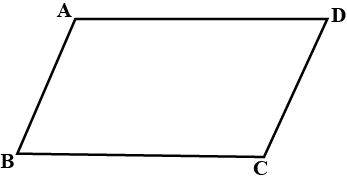
In a parallelogram, the sum of adjacent angles is
A) $90^\circ$
B) $180^\circ$
C) $270^\circ$
D) $360^\circ$
Answer
608.4k+ views
Hint: Two angles are said to be Adjacent when they have a common side and a common vertex (corner point) and don't overlap. We will use this and the fact that for two parallel lines and a transversal in between Interior angles on the same side of transversal are supplementary.
Complete step-by-step answer:
To proceed this question, we will define what is a parallelogram, A flat shape with 4 straight sides where opposite sides are parallel. And the opposite sides are equal in length, and opposite angles are equal.
And Two angles are Adjacent when they have a common side and a common vertex (corner point) and don't overlap.
We will first consider a parallelogram ABCD and draw its figure to understand the question completely.

In the above figure quadrilateral ABCD is a parallelogram.
Then because the opposite sides of parallelogram are parallel therefore,
\[\Rightarrow AD\parallel BC\] and AB is transversal.
Now we know that Interior angles on the same side of the transversal are supplementary, that is they add to make 180.
∴ A + B = $180^\circ$.
Similarly, applying the same concept we get,
∠B + ∠C = $180^\circ$, ∠C + ∠D = $180^\circ$ and ∠D + ∠A = $180^\circ$
∴ The sum of any two adjacent angles of a parallelogram is $180^\circ$.
Observing from the options we get that the option (B) is correct.
Note: Students can make a mistake which is determine the value of all the angels separately and then adding the adjacent angles then see if they sum up to 180. This method would be helpful if the measure of the angles is given but not when the parallelogram is arbitrary.
Complete step-by-step answer:
To proceed this question, we will define what is a parallelogram, A flat shape with 4 straight sides where opposite sides are parallel. And the opposite sides are equal in length, and opposite angles are equal.
And Two angles are Adjacent when they have a common side and a common vertex (corner point) and don't overlap.
We will first consider a parallelogram ABCD and draw its figure to understand the question completely.

In the above figure quadrilateral ABCD is a parallelogram.
Then because the opposite sides of parallelogram are parallel therefore,
\[\Rightarrow AD\parallel BC\] and AB is transversal.
Now we know that Interior angles on the same side of the transversal are supplementary, that is they add to make 180.
∴ A + B = $180^\circ$.
Similarly, applying the same concept we get,
∠B + ∠C = $180^\circ$, ∠C + ∠D = $180^\circ$ and ∠D + ∠A = $180^\circ$
∴ The sum of any two adjacent angles of a parallelogram is $180^\circ$.
Observing from the options we get that the option (B) is correct.
Note: Students can make a mistake which is determine the value of all the angels separately and then adding the adjacent angles then see if they sum up to 180. This method would be helpful if the measure of the angles is given but not when the parallelogram is arbitrary.
Recently Updated Pages
The number of solutions in x in 02pi for which sqrt class 12 maths CBSE

Write any two methods of preparation of phenol Give class 12 chemistry CBSE

Differentiate between action potential and resting class 12 biology CBSE

Two plane mirrors arranged at right angles to each class 12 physics CBSE

Which of the following molecules is are chiral A I class 12 chemistry CBSE

Name different types of neurons and give one function class 12 biology CBSE

Trending doubts
Fill the blanks with the suitable prepositions 1 The class 9 english CBSE

Who among the following opened first school for girls class 9 social science CBSE

What does the word meridian mean A New day B Midday class 9 social science CBSE

What is the full form of pH?

Write the 6 fundamental rights of India and explain in detail

Which places in India experience sunrise first and class 9 social science CBSE




